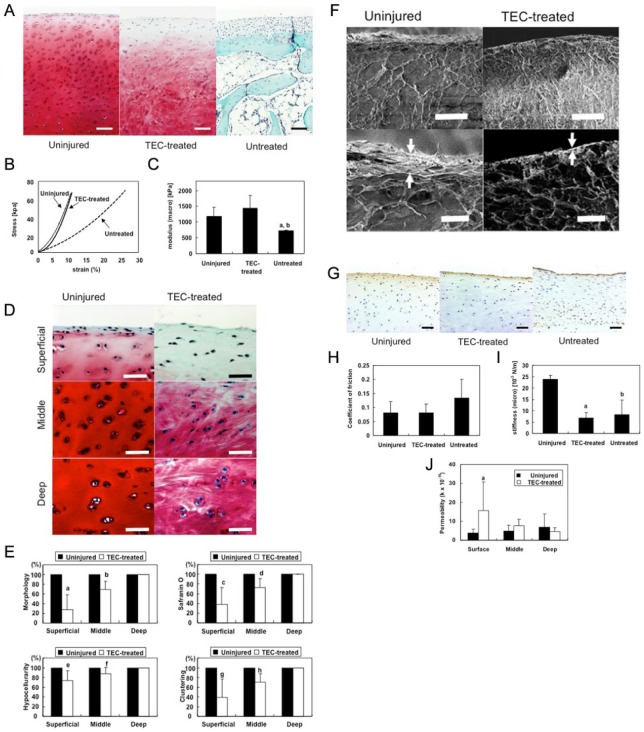Figure 9.
Comparison of zonal structure and mechanical properties of repair cartilage generated from a porcine-derived tissue-engineered construct (TEC). (A) Safranin O staining of uninjured normal porcine articular cartilage and chondral lesions treated with or without a TEC at 6 months after implantation. Bar = 100 μm. (B) Typical stress–strain relationships of TEC-treated repair tissue compared with those of uninjured cartilage and defects left untreated. (C) Tangent modulus of uninjured cartilage (n = 10), repair tissue in chondral lesions of the group treated with a TEC (n = 6), and those in the untreated group (n = 3) at compression rate of 4 μm/s. aP < 0.05, compared with uninjured cartilage. bP < 0.05 compared with the TEC-treated group. There were no significant differences between the tangent modulus of TEC-mediated repair tissue and that of uninjured cartilage. (D) Safranin O staining of superficial, middle and deep zone of porcine chondral lesions 6 months after implantation of TECs and uninjured cartilage. Bar = 25 μm. (E) Zonal histological and histochemical grading scale of uninjured articular cartilage and TEC-mediated repair tissue (n = 8). a,c,gP < 0.001; b,d,hP < 0.01; e,fP < 0.05 compared with the uninjured cartilage. (F) Scanning electron microscopic (SEM) view of normal porcine cartilage and chondral lesions treated with a TEC at 6 months after implantation (upper pictures). Bar = 100 μm. Higher magnification SEM view of uninjured porcine cartilage and chondral lesions treated with a TEC (lower pictures). Bar = 25 μm. Arrow; the thickness of the superficial layer. (G) PRG4/Lubricin expression at the surface zone of uninjured porcine cartilage and chondral lesions treated with or without a TEC. (H) Frictional coefficient of uninjured cartilage (n = 11) and chondral lesions in the TEC-treated group (n = 7) at 60 seconds with the application of a compressive force of 1.76 N. There were no significant differences between the frictional coefficients of repair tissue following implantation of a TEC and those of normal cartilage. (I) The surface stiffness of normal cartilage, the repair tissue of chondral lesions in the TEC-treated group, and that in the untreated group. aP < 0.05, bp < 0.05 compared with normal cartilage. (J) Permeability of uninjured cartilage (n = 11) and repair tissue in chondral lesions of the TEC-treated group (n = 7) at the surface, middle, and deep zone. aP < 0.05, compared with normal cartilage.

